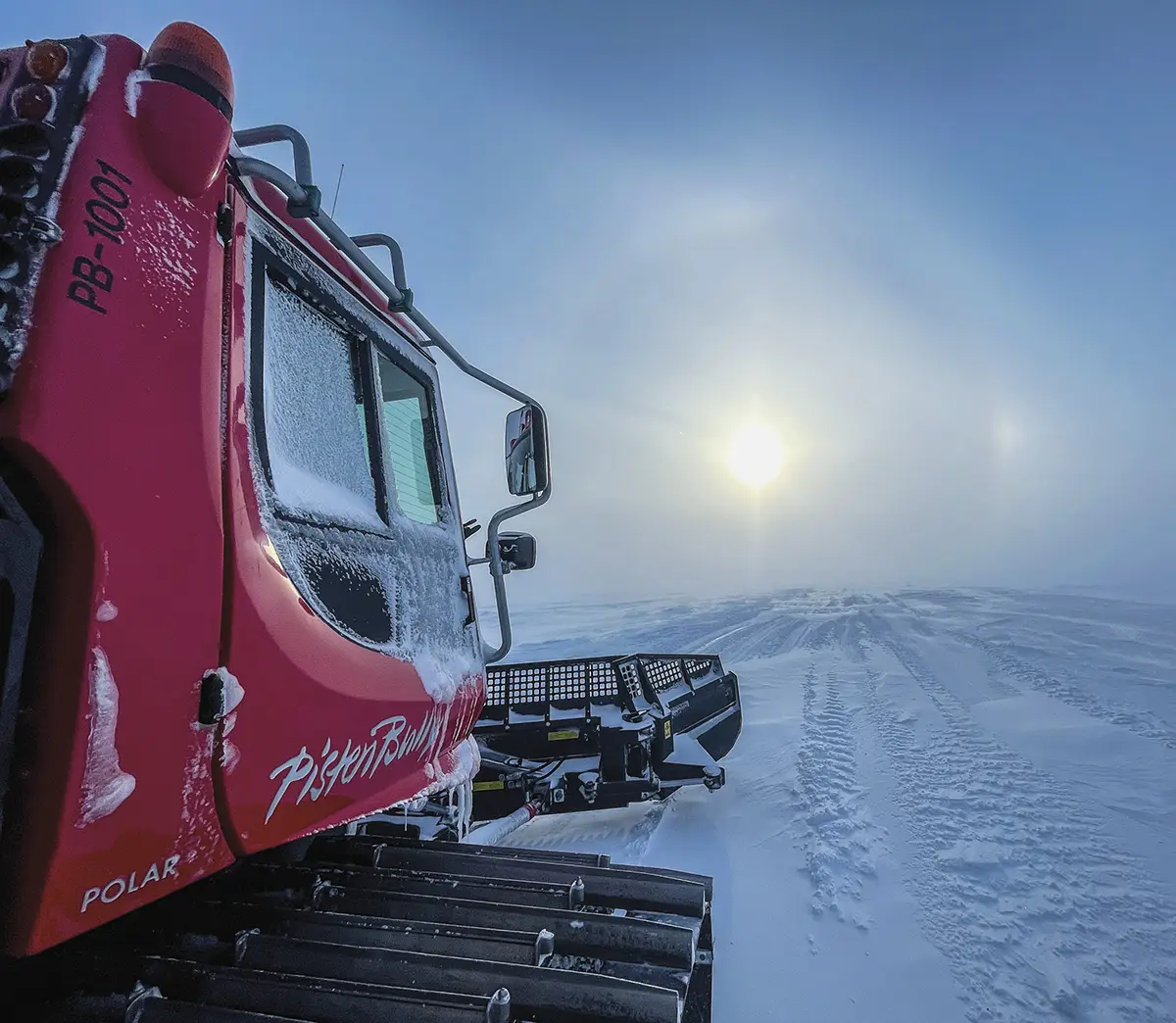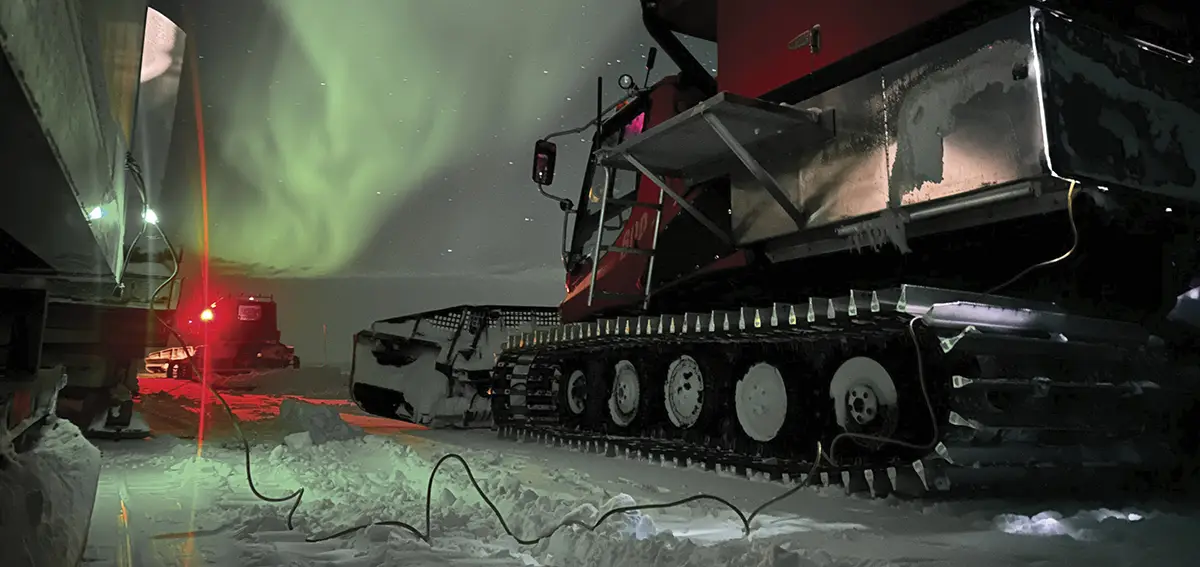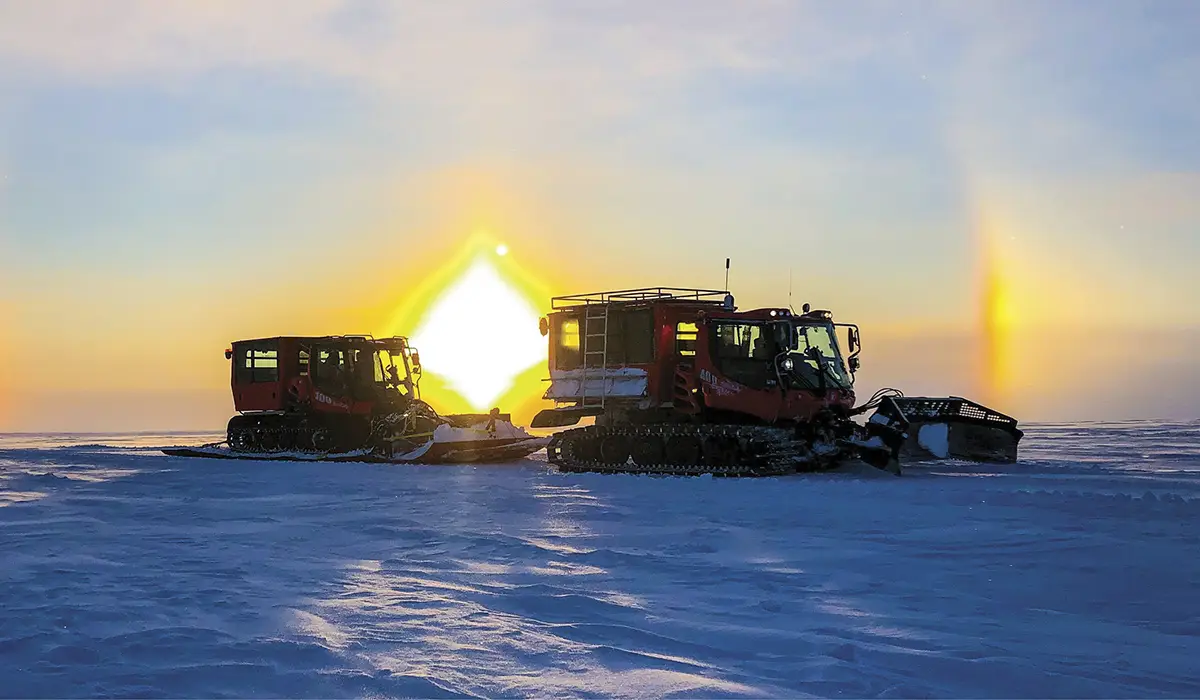hether on foot, by dog teams, or in kayaks, the Iñupiat people of Alaska’s North Slope maintain a mobile culture, traveling great distances through a harsh climate. Hunters follow bowhead whales to summer feeding grounds or track caribou herds to the upper Utukok and Colville rivers. Traditional navigation across the mostly featureless terrain involved specific landmarks or the stars.
Inter-village travel is faster and easier in an era of snowmachines, all-terrain-vehicles, trucks, and cars. Residents of Wainwright or Atqasuk might go to Utqiaġvik for shopping or medical appointments, says James Koonaloak, field operations manager for Eskimos, Inc., part of the Arctic Slope Regional Corporation family of companies.
Cultural events, basketball tournaments, community celebrations, and family visits draw residents between villages. Many of these trips are made by airplane or boat, given that the only cross-country road in the North Slope Borough (NSB), a land area larger than Utah, terminates at Deadhorse.
Yet land routes remain an option, says Jocelyn Pili of Utqiaġvik. “While air travel and barge shipments remain crucial, the historical interconnectedness of villages via ‘tundra travel’ is vital. Traditional hunting practices and other activities, like bartering and trading, have shaped the land routes used today,” she says.
Away from the coast, the communities of Atqasuk and Anaktuvuk Pass are landlocked, yet they need regular deliveries of bulk fuel for electricity and heat. “The only way in and out of there with freight is either overland in winter or large equipment via air,” says Jake Wise, an equipment operator with Ukpeaġvik Iñupiat Corporation (UIC).
That overland option is known as the Community Winter Access Trail (CWAT), a seasonal land link for North Slope villages.
Utqiaġvik, Wainwright, and Atqasuk are surrounded by the National Petroleum Reserve-Alaska (NPR-A) managed by the US Department of Interior. Thus, crossing the reserve requires federal permission. The US Bureau of Land Management (BLM) Arctic District Office, in cooperation with the State of Alaska and NSB government, authorized a right-of-way through NPR-A starting in January 2019. The CWAT program initially had a five-year sunset date, but the permit was recently renewed for another five years.
Broken into two sections, CWAT follows historic snow trails used by traditional hunters. The Northern Route heads west from Prudhoe Bay to Utqiaġvik and Wainwright along the coast and inland to Atqasuk. The Southern Route starts from Galbraith Lake along the Dalton Highway and traverses west across the foothills of the Brooks Range to the community of Anaktuvuk Pass.
UIC Oil & Gas

Escorted caravans can start as early as mid-February and continue through April. During this period the trails are groomed and maintained, especially after snow drifts created by winter storms obliterate the route. Trails are decommissioned at the end of the season, removing all trail markers and signage. However, this schedule is driven entirely by weather.
Only vehicles approved by the Alaska Department of Natural Resources for tundra travel are used to build and maintain the trail. Typical equipment includes Tucker and PistenBully snowcats mounted on huge rubber tires or tracks, says Koonaloak.
Equipment operator Wise, originally from Homer, knows the trail well. He begins building the trail from Prudhoe Bay to Utqiaġvik using a PistenBully 600 snowcat, then 127 miles from Utqiaġvik to Wainwright, and 68 miles Utqiaġvik to Atqasuk as well. Some years the crew runs to Point Lay, 220 miles southwest of Utqiaġvik on the coast.

UIC Oil & Gas
“I spend most of my hitches living out of this cat,” says Wise. “Only three of the last thirty-four days have I slept in camp.”
Traveling the 300 miles from Prudhoe Bay to Utqiaġvik can take twelve days initially.
“Every day is an adventure up here. The weather’s always changing,” says Wise. “It can go from 20°F above to 65 or 70°F below, ice fog to sunny days to Phase 3 visibility, driving by GPS navigation only.” In the heart of winter, of course, there are no sunny days; north of the Arctic Circle, the sun barely rises above the horizon from October to March.
Breaking trail at the beginning of the season is slow and rough. “It’s a desert up here,” he continues. “You get your snow in October and November and a little bit in December. A few snowstorms later, most of the snow is just blowing around, from one end of the Slope to the other.”
Travel time diminishes to as little as three days after the snow trail sets, ready for limited public use.
To prevent that from happening, travel by private vehicles on the CWAT is only done under escorted caravans. Commercial freight haulers may travel unescorted.
The Safe Traveler’s and Environment Program developed by Eskimos, Inc. and NSB Planning and Community Services requires an orientation course for caravan drivers. Vehicle inspections determine the trail worthiness of the vehicle. Vehicles must be clean, 4-wheel or all-wheel drive, with tow connections in the front and rear, sufficient fuel capacity, and two licensed drivers per vehicle, among other stipulations.
Eskimos, Inc. or subcontractors, which include UIC, conduct the caravans with two vehicles, one at the head and one at the end of the caravan, says Koonaloak. Escort vehicles are equipped with all safety equipment, extra fuel, communications gear, and tow sleds to assist a stuck or disabled vehicle.
If a caravan is caught in a blizzard, the caravan leader and support staff direct the drivers to hunker down in their vehicles until the storm passes or drive safely through it, says Kristin Gutierrez-Edwards, NSB’s assistant to the land management administrator and acting deputy director of planning. She experienced a storm while driving a car up the CWAT, but the caravan was able to drive through it by going slowly and safely.
The eastbound Northern Route ends at a drill pad east of the Colville River near Deadhorse, but escorted vehicles are brought to nearby Harry K. Brower Jr Technical Training Center for staging. From there, drivers continue on the 414-mile Dalton Highway to Fairbanks or beyond. The haul road, famously lonesome on its own, is like a freeway after days on CWAT.
NSB records indicate fifty-eight caravans including approximately 140 vehicles made the 3-to-33-hour trek across the tundra during the 2022-2023 season.
Blue Goose Hauling is fairly new to the transport business, established in 2022 in Utqiaġvik. Jocelyn Pili co-owns the service with her husband, Zach, and the business is named in honor of Zach’s maternal great-grandparents. They ran the Point Barrow Trading Post in the ’60s and ’70s under the VHF radio handle “Blue Goose Base.”
Prompted by requests from family and friends for assistance with transporting vehicles, the Pilis were inspired to establish their own business. CWAT makes that possible. “The development has enhanced opportunities for North Slope communities by enabling transportation of larger equipment, vehicles of all sizes, and housing materials to their hometowns and all the villages in between,” says Jocelyn.
Trail conditions have improved since CWAT’s early years, Zach adds. In the first seasons, the trail was rough and lacked markers, but now trails are smoother, and the route has signs and delineators as well.
UIC Oil & Gas

One of the first companies to transport cargo overland between Deadhorse and Utqiaġvik was Arnie’s Northern Outfit & Cargo. Arnie Arey started the company pre-CWAT, in 2010, by modifying a heavy-duty pickup truck with tracks instead of tires and building a custom 22-foot-long sled.
Now a CWAT traveler, Arey started his 2023-2024 season March 1, patiently waiting for a call to pick up freight at the Utqiaġvik airport and take it to Wainwright. Some years it’s difficult to get motivated, Arey says, but it’s the people and the companies who need his services that keep him going.
Depending on the order and the weather, he and his crew of two or three drivers can make the trip to and from Fairbanks in four days, nonstop, taking turns sleeping.
Building materials are always popular, and Arey is taking notes. “I want to build myself a house, so I’ve been hauling stuff like that so when it comes to building my own, I have all the experience with what I need. I can hire myself,” he says.
Apart from housing, the cost of living is notoriously high. Milk can be more than $10 a gallon, and a twelve-pack of soda costs up to $17. Roundtrip airfare from Utqiaġvik to other villages runs from $374 to $554.
The CWAT program is helping alleviate some of that burden.
“Village residents are now able to drive vehicles to bigger cities/villages and have lower costs of goods and supplies,” says Gutierrez-Edwards. “Compared to a barge service or cargo service that may charge thousands of dollars, they can now go and purchase their goods at lower prices.”
“It’s really wonderful for the communities,” Damiano says.
In Gray’s opinion, CWAT is proof of concept for possible future infrastructure. “The only thing that will cut the cost of building in the Arctic by half is a road. The CWAT helps connect, but ultimately it needs to be used to show how vital a year-round road is to having a healthy, strong community,” he says. “You have to build connections.”